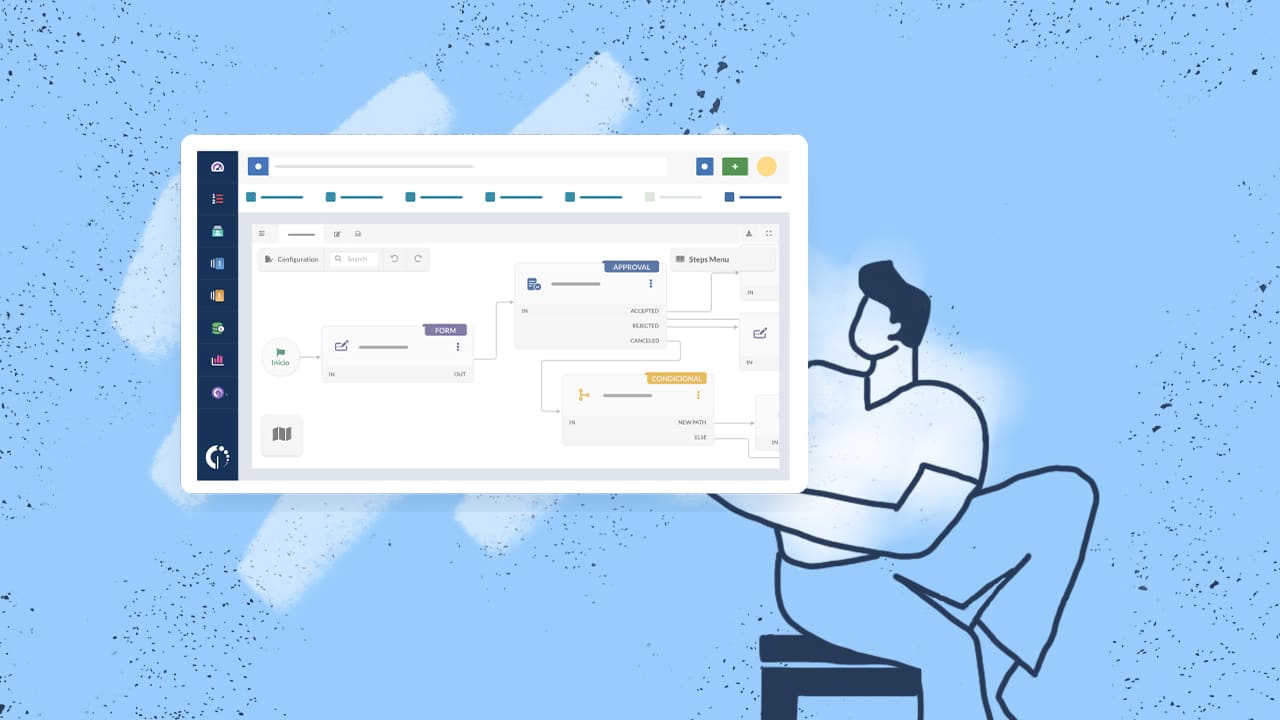Building a robust workflow takes time and requires mapping out all the details of what everyone is doing. But, once it is set, you’ll soon see the positive results that come with Workflow Management and implementing the right automation tools.
The practice leverages software and tools to automate routine tasks, streamline operations, and reduce the likelihood of errors. Effective Workflow Management speeds up processes and provides a clear framework for tracking progress and accountability.
This article focuses specifically on IT and other business process workflows that can be automated using technology.
Join us as we explore this powerful practice and see how it can transform your business operations!

Table of contents
- What is Workflow Management?
- 10 benefits of using a Workflow Management tool.
- Workflows types and components.
- How to get started with the Workflow Management process.
- When should you invest in Workflow Management automation?
- Workflow Management examples and templates.
- How to use the service desk as your Enterprise Workflow Management (EWM) software.
- 6 Workflow Management best practices.
What is Workflow Management?
Let’s start with the basics. Workflow Management refers to the coordination and control of the processes and tasks that make up a business's workflow. It involves planning, executing, and monitoring workflows to ensure they are completed efficiently and effectively.
In practice, a workflow typically consists of a series of tasks that must be completed in a specific order to achieve your organization’s goals.
With the right technology, you can include individual tasks a also integrate processes across different departments
IT workflows typically involve processes related to software development, system administration, Network Management, and Data Management, among others. Automating these can lead to significant improvements in speed, accuracy, and consistency.
For example, automation can handle repetitive tasks such as data entry, system updates, or regular maintenance checks, freeing up IT professionals to focus on more complex and strategic activities.
Similarly, other business process workflows that benefit from automation include those in human resources, finance, and operations. The options are almost endless, since with automation you could streamline employee onboarding, invoice processing, Inventory Management, and much more.

Workflow vs. process: Is there any difference?
While the terms "workflow" and "process" are often used interchangeably, there are subtle differences between them.
- A process is a broader term that refers to a sequence of activities aimed at achieving a particular outcome.
- A workflow, on the other hand, is more specific. Think of it as the whole operational aspect of the tasks within the process. It focuses on the sequence of tasks needed to complete a specific job. In a workflow, for instance, you can add the movement of documents or information from one step or person to another.
10 benefits of using a Workflow Management tool
If you are a modern business aiming to optimize your operations and improve team dynamics both internally and externally, we can’t stress enough how beneficial it is to use software to design workflows. Just take a look at these benefits.
- Automation: Automates routine tasks, reducing manual effort and minimizing errors.
- Efficiency: Streamlines tasks by identifying and eliminating bottlenecks and unnecessary steps.
- Visibility: Provides clear oversight of workflows, allowing managers and teams to track progress in real-time and better understand operational dynamics.
- Coordination: Defines roles and responsibilities clearly, improving coordination among team members and reducing overlaps.
- Consistency: Ensures that every task is performed consistently and to set standards, which is something you want for quality control and compliance.
- Scalability: Adapts and supports the expansion of your organization.
- Compliance: Updates workflows automatically as regulations change to fast your team won’t even notice.
- Data-driven insights: Generates valuable analytics that provide insights into team performance.
- Reduced costs: Lowers operational costs by improving efficiency and reducing the time spent on tasks and error correction.
- Accountability: Provides a clear view of expectations, which enables employees to take ownership of their tasks
Workflow types and components
Visualize your organization’s duties as if they were part of a circuit. They might be very straightforward or they could have extra connections that lead to other circuits. Each of these are workflows and what they do is to provide a structured approach to managing your business processes. And, of course, they are tailored to different operational needs and environments.
Let’s take a look at the different workflow types and components.
Sequential workflow
It’s in the name. It’s great if your business goal is to set a fixed series of steps that proceed in a specific order, where each step must be completed before the next one can begin. It’s the best option if your organization has predictable processes that do not require deviation.
It typically includes triggers that initiate the workflow, tasks that are performed in order, minimal decision points primarily for error handling, and end points that signify the completion of the process.
State machine workflow
This one is more dynamic than the sequential since it has the ability to move back and forth between states based on certain conditions or events. Key components include various states that represent conditions of the workflow, transitions that are movements between states triggered by actions or events, actions that are tasks performed in each state, and events that trigger transitions.
Rule-based workflow
Rule-based workflows operate on specific business rules or logic to dictate the flow of processes. This flexible workflow adjusts dynamically based on complex decision-making processes.
It is built around a rules engine that evaluates and applies business rules, with predefined logic that dictates progression, tasks or actions that are executed based on rule outcomes, and conditions that determine which rules apply.
Parallel workflow
Parallel workflows facilitate multiple processes running simultaneously, ideal for scenarios where tasks do not depend on the completion of others.
This workflow structure speeds up the overall process by allowing concurrent paths to operate independently, synchronization points where these paths may need to converge, and tasks that are performed within each path. Triggers are used to initiate parallel tasks.
Event-driven workflow
This type of workflow is initiated or altered by specific events rather than the completion of preceding tasks. We can call this one reactive since it’s suitable for environments where external factors frequently impact the flow.
It includes event listeners that monitor for specific occurrences, event handlers that execute actions in response to these events, tasks that are part of event handling, and conditional logic that determines the flow based on the events that occur.
How to get started with the Workflow Management process

Getting started with a Workflow Management process involves these key steps.
- Define the objective: Begin by clearly defining the purpose of the workflow. What are you trying to achieve? This could be improving a specific process, automating tasks, or managing projects more effectively.
- Identify the tasks: List and categorize all the tasks that need to be completed to achieve the workflow's objective. And we mean ALL of them; think of both major tasks and smaller sub-tasks.
- Map out the process: Create a visual representation of the workflow. This is where you design that circuit. For that use flowcharts or specialized workflow management tools to identify what are the sequence of tasks, decision points, and any dependencies or conditions between tasks.
- Assign roles and responsibilities: Determine who will be responsible for each task within the workflow.
- Set up tools and resources: Identify the tools and resources needed to execute the workflow. Software tools that offer automation are the best.
- Implement the workflow: Once the workflow is designed, it's time to implement it. Inform everyone about the new workflow and provide any necessary training or instructions.
- Monitor and evaluate: The first stage of implementation is always a prototype so continuously monitor the workflow's performance once it is in operation. Gather feedback from participants and evaluate the workflow against the initial objectives. Look for any bottlenecks or inefficiencies.
- Iterate and improve: Based on the feedback and evaluation, make necessary adjustments to improve the workflow. You might find yourself reassigning tasks, changing the tools used, or even redefining some of the workflow’s objectives.
- Document the workflow: Ensure that all aspects of the workflow are well documented. Make sure to include steps, tools, roles, and any rules or guidelines. A robust knowledge base is great in training new team members properly.

When should you invest in Workflow Management automation?
Investing in Workflow Management automation becomes essential when certain conditions in your business or organization start to manifest.
These conditions typically indicate that the existing manual processes or semi-automated systems are no longer sufficient to meet the demands of the workload or the efficiency required for competitive performance.
Here are some key scenarios when you should consider investing in Workflow Management tools:
- When the number of tasks or the complexity of processes increases to a point where manual handling leads to errors, delays, or inefficiencies.
- If your organization is scaling up and you anticipate a significant increase in workload or expansion into new markets or services.
- If you belong to an industry where regulatory compliance and data accuracy are critical (such as healthcare, finance, and legal).
- When you start noticing that manual processes are leading to high labor costs or that there is a significant amount of time being spent on repetitive tasks. Automation frees up valuable human resources.
- When you and your colleagues are bogged down by manual, repetitive tasks, and as a result are having issues with productivity and work satisfaction.
- If your decision-making processes require real-time data and analytics. Automation tools can provide continuous insights and reporting.
- When your organization is experiencing customer experience concerns because you are not able to provide consistent service delivery and personalized customer interactions.
Workflow Management examples and templates
These examples demonstrate how Workflow Management can be applied to different aspects of business operations, from human resources to project management and customer service.
Employee onboarding and offboarding workflow
An onboarding workflow streamlines the process of integrating new employees into the organization and ensures a smooth exit for departing employees. For example:
- Steps in Onboarding: Collecting employee documents, setting up workplace tools and access, scheduling training sessions, and assigning mentors.
- Steps in Offboarding: Deactivating access rights, conducting exit interviews, finalizing payroll, and retrieving company assets.

Change request workflow
A change request workflow manages the process of requesting, reviewing, and implementing changes within projects or day-to-day operations.
Steps: Submission of change request, initial review, impact analysis, approval/rejection, implementation, and post-implementation review.

Knowledge Management workflow
To be more specific, now think of a workflow that facilitates the creation, review, approval, and publication of knowledge articles within an organization: The Knowledge Management process.
Steps: Article ideation, writing, content review, SEO optimization, final approval, and publication.

Customer service ticket handling workflow
If you care about customer satisfaction you are going to want to build a workflow that ensures efficient and effective resolution of customer issues through a structured process.
Steps: Ticket creation, assignment to appropriate team, problem-solving, communication with the customer, resolution, and feedback collection.
Project approval workflow
It’s also a great idea to create one that standardizes the process of approving new projects within an organization, to ensure all necessary criteria and approvals are met before commencement and that everyone’s voices and ideas are heard.
Steps: Project proposal submission, review by relevant stakeholders, budget approval, resource allocation, and official project launch.
How to use the service desk as your Enterprise Workflow Management software
Using a service desk as your Enterprise Workflow Management (EWM) software is a strategic approach that aligns with Enterprise Service Management (ESM) principles.
To sum up, ESM extends the Service Management practices well-known in IT to other departments within an organization, such as HR, facilities, and finance.
Workflow Management is a key aspect of all well functioning service desk’s, as they allow you to prioritize tickets efficiently and organize your agents work accordingly.

So, here are some ideas on how you can effectively use a service desk to automate workflows across the organization:
- Streamline your response and resolution processes by implementing a single point of contact for all service requests across the organization. This centralized approach ensures that whether an employee needs IT support, HR assistance, or Facilities Management, they can submit their request through the same system.
- Configure the service desk to automatically route tickets and requests to the appropriate department or team based on predefined criteria. For example, IT-related requests go directly to the IT department, while HR requests are routed to the Human Resources team.
- Use the service desk to implement standardized workflows for common processes across different departments. For instance, onboarding a new employee can involve multiple departments, and having a standardized workflow ensures that each step is executed according to policy and in the correct sequence.
- Service Level Agreements (SLAs) can be managed through the service desk to ensure that all requests are handled within the agreed-upon time frames. SLAs can be customized for different types of requests or departments.
- Utilize the service desk’s capabilities to track the progress of requests and generate real-time reports. As a manager you’ll be able to monitor workflow efficiency and identify bottlenecks to make informed decisions.
- Integrate the service desk with other enterprise systems such as HRMS, CRM, ERP, and project management tools to allow for seamless data exchange and automation of workflows across platforms. For example, a new hire in the HR system can automatically trigger IT provisioning processes through the service desk.
- Leverage the service desk to collect feedback from users at the end of each request.
- For protection, configure the service desk to manage access control and ensure that sensitive information is only accessible to authorized personnel.
For this, InvGate Service Management's no-code workflow builder enables users to swiftly define their workflows by dragging and dropping components into the process to set out its steps.
The function was designed with an intuitive UX/UI, making it flexible enough for it to be used by different teams across the organization.
6 Workflow Management best practices
And lastly, here are six actionable strategies to enhance your organizational workflows and ensure they operate smoothly, even under pressure:
1. Develop a clear workflow documentation
Start by documenting your workflows in a clear and concise manner. This could be as simple as a diagram on a whiteboard or a detailed schematic using specialized software. The aim is to visualize the process so that everyone understands the steps involved and what to do when issues arise.
2. Anticipate and plan for obstacles
When designing workflows, think ahead about potential snags. For each step, consider possible failures or delays and establish predefined responses. Forward-thinking minimizes downtime and prepares your team to handle disruptions smoothly.
3. Identify and prioritize critical steps
Not every step in a workflow carries the same weight. Determine which steps are critical for initiating and completing processes, and focus on these areas. Understanding the significance of each step helps in allocating resources and attention where they are most needed, especially when dealing with constraints.
4. Equip your team adequately
Delays often occur because team members lack necessary resources or information. Ensure that everyone involved has the tools, access, and knowledge required to execute their tasks efficiently. Regular communication and support can preempt many common workflow issues.
5. Implement strategic automation
Evaluate your processes to identify which steps can be automated to reduce error and improve efficiency. Automation is particularly useful for repetitive tasks that do not require human discretion.
6. Regularly audit your workflows
Conduct thorough audits of your workflows to ensure they are optimized for current conditions. Regular reviews might reveal hidden bottlenecks or inefficiencies that might not be evident during daily operations. Aim to perform these audits biannually or following any major changes within the organization.
To sum up
When it comes to Workflow Management each workflow can be customized with specific steps and rules to fit the unique requirements of your organization.
But, given all the scenarios we’ve discussed so far, workflow management automation isn't just about technology investment but about strategically enhancing operational efficiency, employee performance, and customer satisfaction.
Consider adopting an Enterprise Workflow Management software approach to streamline operations and to support a unified strategy for service management across all departments, aligning with the broader goals of Enterprise Service Management.















